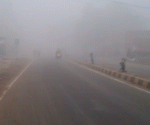Mangoes faced harsh reality of heatwave | Patna News – Times of India

PATNA: Sunburn isn’t just a human problem; fruits like mangoes can also fall victim to its effects. If you’ve ever noticed mangoes with uneven ripeness or faded skin colour, you’ve witnessed the consequences of sunburn firsthand. The culprit behind this phenomenon is the intense heatwave that swept across north India this summer, with Bihar being no exception.The scorching temperatures and relentless sun took a toll on both the plant and animal kingdoms, leaving nothing untouched.
The effect of the heatwave is not just limited to sunburn, but scientists, and even common people, have noticed a change in the size and taste of mangoes in the last few years.
Agricultural scientist S K Singh of Dr Rajendra Prasad Central Agricultural University, Pusa, Samastipur, says they have noticed a significant reduction in size among all the mango varieties this year, due to the intense heat. “The Amrapali variety of mango, known for its size, has seen the highest reduction in fruit size – 30% to 40% less than last year. Similarly, the Dussehri variety has seen a reduction of 20% to 30% in fruit size, while the Malda, Mallika, and Hemsagar varieties have seen 10 to 30% reduction compared to last year,” says Singh, the head of the department of plant pathology and nematology at the university.
Not just the size, the production of the fruit has also reduced.
Abhishek Kumar, director (horticulture) of the agriculture department, said some farmers have reported a decline in the production of the early varieties of mangoes like Bhagalpur’s Zardalu – which also has a geographical indication (GI) tag – due to the heatwave. “But the production of other varieties may increase. Since we are in the midst of the harvest season, we can’t say that the overall production has been impacted. According to our advanced estimate, however, our production has increased from last year,” Kumar said.
HEAT WOES
The production of early varieties suffered despite good flowering mainly due to fruit dropping – attributed to the maximum temperature crossing the 40-degrees-Celsius mark and less pre-monsoon showers. “Mango trees require soil with good moisture content, for which they need a good water flow for irrigation. Most of the mango orchards don’t have proper irrigation facilities, while many farmers depend on rainfall for the ripening of the fruit. Since this year saw less pre-monsoon showers — just twice or thrice as compared to at least five times till last year – the unripe fruit started dropping. Also, there are issues of fruit cracking, along with a reduction in their size,” Singh said, adding May rainfall, though unsatisfactory, saved the farmers.
Added to this was an extensive heatwave of over 20 days this year as compared to two to three days in the last few years. High temperatures can also scorch leaves, reducing the tree’s ability to maintain healthy fruit growth.
According to Singh, who has been working on fruits for the last 25 years, the Amrapali variety suffered the worst with not just its size reducing to half but also the fruit texture. The juicy pulp has turned jelly-like due to over-fermentation with a slightly bad smell, rendering it unmarketable, he says, fearing if this continues the farmers will stop cultivating it.
The scientists have noticed at least seven changes like these this year. Apart from size and texture, taste – which is the result of the sugar-acid (TSS) ratio in the fruit – has also changed. With the change in quality, micronutrients are bound to suffer.
WAYS TO TACKLE CLIMATE CHANGE
The scientists have suggested several ways to tackle climate change like drip irrigation and overhead sprinklers. Drip irrigation and sprinklers help reduce the temperature by up to 5 degrees C in the orchard. “The ideal temperature in a mango orchard should not be more than 37 degrees C. Soil moisture can also be retained by using organic mulch around the base of the mango trees, which reduces soil temperature and prevents weed growth,” Singh added.
The effect of the heatwave is not just limited to sunburn, but scientists, and even common people, have noticed a change in the size and taste of mangoes in the last few years.
Agricultural scientist S K Singh of Dr Rajendra Prasad Central Agricultural University, Pusa, Samastipur, says they have noticed a significant reduction in size among all the mango varieties this year, due to the intense heat. “The Amrapali variety of mango, known for its size, has seen the highest reduction in fruit size – 30% to 40% less than last year. Similarly, the Dussehri variety has seen a reduction of 20% to 30% in fruit size, while the Malda, Mallika, and Hemsagar varieties have seen 10 to 30% reduction compared to last year,” says Singh, the head of the department of plant pathology and nematology at the university.
Not just the size, the production of the fruit has also reduced.
Abhishek Kumar, director (horticulture) of the agriculture department, said some farmers have reported a decline in the production of the early varieties of mangoes like Bhagalpur’s Zardalu – which also has a geographical indication (GI) tag – due to the heatwave. “But the production of other varieties may increase. Since we are in the midst of the harvest season, we can’t say that the overall production has been impacted. According to our advanced estimate, however, our production has increased from last year,” Kumar said.
HEAT WOES
The production of early varieties suffered despite good flowering mainly due to fruit dropping – attributed to the maximum temperature crossing the 40-degrees-Celsius mark and less pre-monsoon showers. “Mango trees require soil with good moisture content, for which they need a good water flow for irrigation. Most of the mango orchards don’t have proper irrigation facilities, while many farmers depend on rainfall for the ripening of the fruit. Since this year saw less pre-monsoon showers — just twice or thrice as compared to at least five times till last year – the unripe fruit started dropping. Also, there are issues of fruit cracking, along with a reduction in their size,” Singh said, adding May rainfall, though unsatisfactory, saved the farmers.
Added to this was an extensive heatwave of over 20 days this year as compared to two to three days in the last few years. High temperatures can also scorch leaves, reducing the tree’s ability to maintain healthy fruit growth.
According to Singh, who has been working on fruits for the last 25 years, the Amrapali variety suffered the worst with not just its size reducing to half but also the fruit texture. The juicy pulp has turned jelly-like due to over-fermentation with a slightly bad smell, rendering it unmarketable, he says, fearing if this continues the farmers will stop cultivating it.
The scientists have noticed at least seven changes like these this year. Apart from size and texture, taste – which is the result of the sugar-acid (TSS) ratio in the fruit – has also changed. With the change in quality, micronutrients are bound to suffer.
WAYS TO TACKLE CLIMATE CHANGE
The scientists have suggested several ways to tackle climate change like drip irrigation and overhead sprinklers. Drip irrigation and sprinklers help reduce the temperature by up to 5 degrees C in the orchard. “The ideal temperature in a mango orchard should not be more than 37 degrees C. Soil moisture can also be retained by using organic mulch around the base of the mango trees, which reduces soil temperature and prevents weed growth,” Singh added.
















